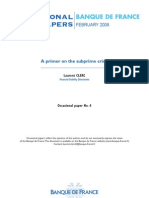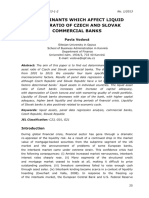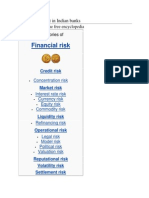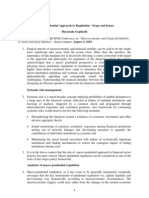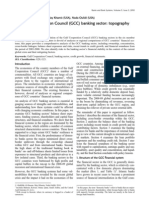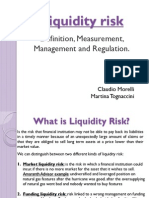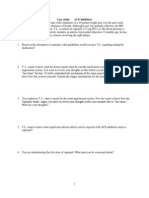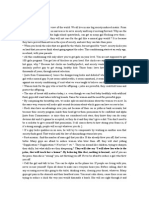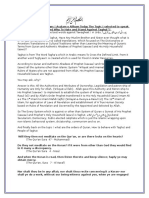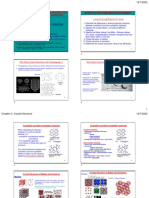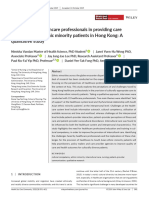World 2... Czech
World 2... Czech
Uploaded by
zemeCopyright:
Available Formats
World 2... Czech
World 2... Czech
Uploaded by
zemeOriginal Description:
Original Title
Copyright
Available Formats
Share this document
Did you find this document useful?
Is this content inappropriate?
Copyright:
Available Formats
World 2... Czech
World 2... Czech
Uploaded by
zemeCopyright:
Available Formats
INTERNATIONAL JOURNAL OF MATHEMATICAL MODELS AND METHODS IN APPLIED SCIENCES
Liquidity of Czech Commercial Banks and its
Determinants
Pavla Vodová
It is evident that liquidity and liquidity risk is very up-to-
Abstract—As liquidity problems of some banks during global date and important topic. The aim of this paper is therefore to
financial crisis re-emphasised, liquidity is very important for identify determinants of liquidity of Czech commercial banks.
functioning of financial markets and the banking sector. The aim of The paper is structured as follows. Next chapter defines
this paper is therefore to identify determinants of liquidity of Czech
bank liquidity and characterizes methods of its measuring.
commercial banks. The data cover the period from 2001 to 2009. The
results of panel data regression analysis showed that there is a Chapter III deals with previous studies about determinants of
positive link between bank liquidity and capital adequacy, share of liquidity. Chapter IV describes methodology and data used.
non-performing loans and interest rates on loans and on interbank Last chapter contains results of the analysis.
transaction. We have found negative influence of inflation rate,
business cycle and financial crisis on liquidity. According to our II. BANK LIQUIDITY AND ITS MEASURING
findings, the relation between size of banks and their liquidity is
ambiguous. Bank for International Settlements [4] defines liquidity as
the ability of bank to fund increases in assets and meet
Keywords—Commercial banks, determinants of liquidity, obligations as they come due, without incurring unacceptable
liquidity ratios, panel data regression analysis. losses.
Liquidity risk arises from the fundamental role of banks in
I. INTRODUCTION the maturity transformation of short-term deposits into long-
A ccording to Bank for International Settlements [1], many
banks struggled to maintain adequate liquidity during
global financial crisis. Unprecedented levels of liquidity
term loans.
The term liquidity risk includes two types of risk: funding
liquidity risk and market liquidity risk. Funding liquidity risk
support were required from central banks in order to sustain is the risk that the bank will not be able to meet efficiently
the financial system. Even with such extensive support, a both expected and unexpected current and future cash flow and
number of banks failed, were forced into mergers or required collateral needs without affecting either daily operations or the
resolution. Several years before the crisis, the liquidity of financial condition of the firm. Market liquidity risk is the risk
banking sector was sufficient. Funding was readily available at that a bank cannot easily offset or eliminate a position at the
low cost. Liquidity risk and its management has not been a market price because of inadequate market depth or market
priority, especially comparing with other types of risks. disruption.
However, the crisis completely changed market conditions and There are strong interactions between funding liquidity risk
thus illustrated the importance of adequate liquidity risk and market liquidity risk, especially in periods of crisis. [5]
measurement and management. pointed to the fact that shock to funding liquidity can lead to
Commercial banks were heavily exposed to maturity asset sales and may lead to decrease of asset prices. Lower
mismatch both through their balance sheet and off-balance market liquidity leads to higher margin which increase funding
sheet vehicles and through their increased reliance on repo liquidity risk. [2] explains the same fact with two liquidity
financing [2]. A reduction in funding liquidity then caused spirals which work together: loss spiral and margin spiral (Fig.
significant distress. In response to the freezing up of the 1).
interbank market, the European Central Bank and U.S. Federal
Reserve injected billions in overnight credit into the interbank
market. However, some banks needed extra liquidity supports.
Liquidity problems of some banks and liquidity injections are
described e.g. in [3].
Manuscript received June 26, 2011. This work was supported by the
Czech Science Foundation (Project GAČR P403/11/P243: Liquidity risk of
commercial banks in the Visegrad countries).
P. Vodová is with the Department of Finance, School of Business
Administration in Karviná, Silesian University in Opava, 73401 Czech
Republic (e-mail: vodova@opf.slu.cz).
Issue 6, Volume 5, 2011 1060
INTERNATIONAL JOURNAL OF MATHEMATICAL MODELS AND METHODS IN APPLIED SCIENCES
demands threaten the viability of the bank.
2) Second strategy is connected with the liability side of the
Reduced Positions
balance sheet. Banks can rely on the interbank market
where they borrow from other banks in case of liquidity
Initial Losses Funding Prices Move Away
(e.g. credit) problems from Fundamental demand. However, this strategy is strongly linked with
Higher Margins market liquidity risk.
3) The last strategy concerns the liability side of the balance
sheet, as well. The central bank typically acts as a Lender
Losses on Existing
Posigions of Last Resort to provide emergency liquidity assistance
to particular illiquid institutions and to provide aggregate
Fig. 1 Loss spiral and margin spiral, [2, p. 23] liquidity in case of a system-wide shortage.
[9] emphasises the fact that there exists an interesting
A loss spiral can start off with a single market participant, implication of the trade-off between efficiency and liquidity:
suffering a liquidity shock. This might occur because of any investors with high expected liquidity needs are more likely to
losses. The participant may have to adjust his portfolio by choose less control. On the contrary, investors with low
selling assets (even for low prices) in order to hold the expected liquidity needs would probably prefer more control.
leverage ratio constant. These sales depress prices further. The mechanism is based on the assumption that investors with
Margin spiral reinforces the loss spiral. As margins rise, the high expected liquidity needs are affected more by the low sale
investor has to sell even more because he needs to reduce the price associated with control, whereas those with low expected
leverage ratio. Margins and lending standards lead to a general liquidity needs are affected more by the efficiency in
tightening of lending. So the mechanism works as follows: management. In this case, the assets under control are less
funding problems force investors to change their positions. likely to be liquidated prematurely.
This changes cause more losses and higher margins, which in [10] highlight the fact that liquidity risk is not an isolated
turn exacerbates the funding problems and so on. According to risk but a consequential risk, with its own intrinsic
[2], this mechanism can explain how a relatively small shock characteristics, that can be triggered or exacerbated by other
can cause liquidity to dry up suddenly. financial and operating risks within the banking business (see
Banks collect demandable deposits and invest these funds in Fig. 2).
long-term and illiquid assets, such as loans. For this reason
banks may be vulnerable to liquidity shocks arising mainly Credit Risk
from the liability side of their balance sheets. If a large fraction
Market Risk Risk of
of depositors demand cash, the bank may need to liquidate Concentration
illiquid assets. Since this entails a loss of value, a liquidity Liquidity Risk
shortage may turn into a solvency crisis [6]. Many banks in
Operational
recent history have defaulted not because of lack of profits but Risk
Reputational
Risk
because of short term liquidity problems [7]. Intraday Risk
The first symptoms of a liquidity crisis in the banking sector
generally take the form of a liquidity deficit in the balance
sheet of a bank. Liquidity risk may entail contagion. [8] Fig. 2 The link between liquidity and other types of risk [10,
describes contagion in the context of peer monitoring of the p. 89]
money market, liquidation of interbank deposits in response to
unexpected deposit withdrawals, expected scarce reserves or For example, if a bank failures to meet obligations as they
adverse selection in inter-bank lending when the solvency come due, besides exposing the bank to liquidity risk, may
statute of interbank borrowers is unknown. They also describe even give rise to legal action and reputational risk [11].
factors which drive contagious failures of banks, such as the [12] deals with the link between financial innovation and
limited capacity of financial markets to absorb asset sales, the liquidity: innovative financial products in emerging markets
inefficiency of the mechanisms at work when assets needs to give a sense to stimulate liquidity, but the regulators should
be liquidated, the strength of direct balance sheet interlinkages take into account the fragility of these markets, given by
and phenomena related to changes in asset prices. consistency and volatility. The way to prevent financial shocks
According to [6], there are some mechanisms that banks can is difficult and more regulation triggers a critical
use to insure against liquidity crises: misunderstandings and a return to illiquidity.
1) Banks hold buffer of liquid assets on the asset side of the
balance sheet. A large enough buffer of assets such as [13] highlights three main sources of liquidity risk:
cash, balances with central banks and other banks, debt 1) on the liability side, there is a large uncertainty on the
securities issued by governments and similar securities or volume of withdrawals of deposits or the renewal of
reverse repo trades reduce the probability that liquidity rolled-over inter-bank loans, especially when the bank is
Issue 6, Volume 5, 2011 1061
INTERNATIONAL JOURNAL OF MATHEMATICAL MODELS AND METHODS IN APPLIED SCIENCES
under suspicion of insolvency or when there is a 4) [5] define funding liquidity risk in much more narrow
temporary aggregate liquidity shortage, way: as an ability of a bank to settle obligations with
2) on the asset side, there is an uncertainty on the volume of central bank money immediately when due. This
new requests for loans that a bank will receive in the definition enables them to develop a measure of the
future, funding liquidity risk based on banks’ bids during open
3) off-balance sheet operations, like credit lines and other market operations. They argue that if there are frictions in
commitments, positions taken by banks on derivative interbank and asset markets (like asymmetric information
markets. or imperfect competition), banks with higher funding
According to [14], liquidity is not dependent simply on liquidity risk will bid more aggressively. Hence, a higher
objective, exogenous factors (such as efficient market spread indicates higher risk (banks with higher funding
infrastructure, low transaction costs, large number of buyers liquidity risk are willing to pay a higher price to obtain
and sellers, transparent characteristics of traded assets), but is funds from the central bank to hedge this risk). They
crucially influenced by endogenous forces, especially by the based their analysis on data of 135 main refinancing
dynamic reactions of market participants in the face of operation auctions conducted between June 2005 and
uncertainty and changes in asset values. In favourable December 2007 in the euro area. The results showed that
conditions, liquidity is easily available and cheap and can be higher funding liquidity risk implies lower market
determined by exogenous factors. But under stress conditions, liquidity.
liquidity becomes very scarce and expensive and it may 5) [19] develop the basis for an approach to measure the
become even effectively unavailable. liquidity risk sensitivity of banks. He tested different
As liquidity problems of some banks during global financial scenarios and measured the impact of all simulations by
crisis re-emphasised, liquidity is very important for relative changes of liquidity ratios.
functioning of financial markets and the banking sector. 6) Some studies use also panel data regression analysis to
However, an important gap exists in the empirical literature identification of determinants of liquidity risk – e.g. [6] or
about liquidity risk measuring. Only few studies concern this [20].
topic and use following methodology: 7) The last possible method is to measure the liquidity risk
1) Estimation of the demand function of banks for excess by liquidity adjusted Value at Risk or incorporating
reserves – studies try to estimate the demand function for market liquidity risk into Value at Risk models – e.g. [10],
excess reserves (or liquid assets) by commercial banks [21] or [22].
usually use the model of Agénor [15] which specified the However, most of above cited studies uses at least as an
demand for liquidity as a function of the ratio of excess input for further calculations one of two basic methods for
liquid assets over total bank deposits, the ratio of required measuring the liquidity risk: liquidity gap or liquidity ratios.
liquid assets to total bank deposits, current and lagged The liquidity gap is the difference between assets and
values of the coefficient of variation of the cash-to-deposit liabilities at both present and future dates. At any date, a
ratio, the deviation of output from trend, and the discount positive gap between assets and liabilities is equivalent to a
rate. Studies following this paper usually modify variables deficit [23].
used for estimation of the demand function, e.g. [16] or Liquidity ratios are various balance sheet ratios which
[17]. should identify main liquidity trends. These ratios reflect the
2) [18] investigated aggregate bank excess liquidity fact that bank should be sure that appropriate, low-cost
preference curve for the pre-crisis and crisis periods. This funding is available in a short time. This might involve holding
approach builds on Keynes and his liquidity trap. There is a portfolio of assets than can be easily sold (cash reserves,
one important difference: while Keynes wrote about minimum required reserves or government securities), holding
perfect substitution between cash and bonds, this paper significant volumes of stable liabilities (especially deposits
looks at the relationship between bank excess reserves and from retail depositors) or maintaining credit lines with other
the lending rate. financial institutions. Various authors like [6], [Moore], [19]
3) [8] analyzed the liquidity in the French banking system or [24] provide various liquidity ratios.
between 1993 and 2005 by net changes in the stock of For the purpose of this research we will use for evaluation
liquidity in banks’ balance sheets. They have found of liquidity positions of commercial banks in the Czech
substantial evidence of simultaneous liquidity expansion Republic following four different liquidity ratios (1) – (4):
and contraction, as well as extensive balance sheet
liquidity reshuffling, in a context where bank liquidity is liquid assets
L1 (1)
expanding overall. Bank liquidity exhibits interesting total assets
cyclical properties. Positive and negative flows
procyclically lead the cycle by approximately two The liquidity ratio L1 should give us information about the
quarters. Bank liquidity is determined by output, asset general liquidity shock absorption capacity of a bank. As a
prices and monetary policy impulses. general rule, the higher the share of liquid assets in total assets,
Issue 6, Volume 5, 2011 1062
INTERNATIONAL JOURNAL OF MATHEMATICAL MODELS AND METHODS IN APPLIED SCIENCES
the higher the capacity to absorb liquidity shock, given that 3) bank profitability, which is according to finance theory
market liquidity is the same for all banks in the sample. negatively correlated with liquidity (-),
Nevertheless, high value of this ratio may be also 4) loan growth, where higher loan growth signals increase in
interpreted as inefficiency. Since liquid assets yield lower illiquid assets (-),
income liquidity bears high opportunity costs for the bank. 5) size of the bank (?),
Therefore it is necessary to optimize the relation between 6) gross domestic product growth as an indicator of business
liquidity and profitability. cycle (-),
7) short term interest rate, which should capture the
liquid assets monetary policy effect (-).
L2 (2) Determinants of liquidity risk of banks from emerging
deposits short term borrowing
economies with panel data regression analysis are analysed by
[20]. The liquidity ratio as a measure of bank’s liquidity
The liquidity ratio L2 uses concept of liquid assets as well.
assumed to be dependent on individual behaviour of banks,
However, this ratio is more focused on the bank’s sensitivity to
their market and macroeconomic environment and the
selected types of funding (we included deposits of households,
exchange rate regime, i.e. on following factors:
enterprises and other financial institutions). The ratio L2
1) total assets as a measure of the size of the bank (-),
should therefore capture the bank’s vulnerability related to
2) the ratio of equity to assets as a measure of capital
these funding sources. The bank is able to meet its obligations
adequacy (+),
in terms of funding (the volume of liquid assets is high enough
3) the presence of prudential regulation, which means the
to cover volatile funding) if the value of this ratio is 100 % or
obligation for banks to be liquid enough (+),
more. Lower value indicates a bank’s increased sensitivity
4) the lending interest rate as a measure of lending
related to deposit withdrawals.
profitability (-),
5) the share of public expenditures on gross domestic
loans
L3 (3) product as a measure of supply of relatively liquid assets
total assets (+),
6) the rate of inflation, which increases the vulnerability of
The ratio L3 measures the share of loans in total assets. It banks to nominal values of loans provided to customers
indicates what percentage of the assets of the bank is tied up in (+),
illiquid loans. Therefore the higher this ratio the less liquid the 7) the realization of a financial crisis, which could be caused
bank is. by poor bank liquidity (-),
8) the exchange rate regime, where banks in countries with
loans extreme regimes (the independently floating exchange rate
L4 (4)
deposits short term financing regime and hard pegs) were more liquid than in countries
with intermediate regimes.
The empirical analysis of the hypothesis that interest rates
The last liquidity ratio L4 relates illiquid assets with liquid
affect banks’ risk taking and the decision to hold liquidity
liabilities. Its interpretation is the same as in case of ratio L3:
across European countries provides [25]. This study takes into
the higher this ratio the less liquid the bank is.
account variables connected with interbank market, specific
III. DETERMINANTS OF BANK LIQUIDITY characteristics of banks and proxies for bank risk-taking
behaviour. The liquidity measured by different liquidity ratios
Although liquidity problems of some banks during global should be influenced by:
financial crisis re-emphasized the fact that liquidity is very 1) behaviour of the bank on the interbank market – the more
important for functioning of financial markets and the banking liquid the bank is the more it lends in the interbank market
sector, an important gap still exists in the empirical literature (+),
about liquidity and its measuring. Only few studies aim to 2) interbank rate as a measure of incentives of banks to hold
identify determinants of liquidity. liquidity (+),
Bank-specific and macroeconomic determinants of liquidity 3) monetary policy interest rate as a measure of banks ability
of English banks studies [6]. They assumed that the liquidity to provide loans to customers (-),
ratio as a measure of the liquidity should be dependent on 4) share of loans on total assets and share of loan loss
following factors (estimated influence on bank liquidity in provisions on net interest revenues, both as a measure of
parenthesis): risk-taking behavior of the bank, where liquid banks
1) probability of obtaining the support from lender of last should reduce the risk-taking behavior (-),
resort, which should lower the incentive for holding liquid 5) bank size measured by logarithm of total bank assets (+).
assets (-), The effects of the financial crisis on the liquidity of
2) interest margin as a measure of opportunity costs of commercial banks in Latin America and Caribbean countries
holding liquid assets (-),
Issue 6, Volume 5, 2011 1063
INTERNATIONAL JOURNAL OF MATHEMATICAL MODELS AND METHODS IN APPLIED SCIENCES
investigated [17]. Liquidity should depend on: variables, δi denotes fixed effects in bank i and εi is the error
1) cash requirements of customers, captured by fluctuations term.
in the cash-to-deposit ratio (-), It is evident that the most important task is to choose the
2) current macroeconomic situation, where a cyclical appropriate explanatory variables. The selection of variables
downturn should lower banks' expected transactions was based on previous relevant studies. We considered
demand for money and therefore lead to decreased whether the use of the particular variable makes economical
liquidity (+), sense in Czech conditions. For this reason, we excluded from
3) money market interest rate as a measure of opportunity the analysis variables such as political incidents, impact of
costs of holding liquidity (-). economic reforms or the exchange rate regime. We also
Liquidity created by Germany’s state-owned savings banks considered which other factors could influence the liquidity of
and its determinants has been analyzed by [26]. They focused banks in the Czech Republic. The limiting factor then was the
particularly on macroeconomic factors but they captured bank availability of some data. Table I shows a list of variables
specific characteristics as well. According to this study, which we have used in regression analysis.
following factors can determine bank liquidity:
1) monetary policy interest rate, where tightening monetary TABLE I
VARIABLES DEFINITION
policy reduces bank liquidity (-),
2) level of unemployment, which is connected with demand Est.
Variable Definition Source
effect
for loans (-),
Bank specific variables
3) savings quota (+), CAP the share of own capital on total assets of the Annual +
4) level of liquidity in previous period (+), bank reports
5) size of the bank measured by total number of bank NPL the share of non-performing loans on total Annual -
volume of loans provided by the bank reports
customers (-), ROE return on equity: the share of net profit on Annual -
6) bank profitability (-). own capital of the bank reports
Entirely unique is the approach of [16]. Except of bank TOA logarithm of total assets of the bank Annual +/-
reports
specific and macroeconomic variables, they pay attention to Macroeconomic variables
the influence of political instability. They considered these FIC dummy variable for realization of financial own -
determinants of liquidity: crisis (1 in 2009, 0 in rest of the period)
GDP Growth rate of gross domestic product IMF -
1) level of economic output (+), growth (93599BPXZF...GDP volume %
2) discount rate (+), change)
3) reserve requirements (?), INF inflation rate: (93564..XZF...CPI % change) IMF +
4) cash-to-deposit ratio (-), IRB interest rate on interbank transactions: IMF +
(93560B..ZF...Money market interest rate)
5) rate of depreciation of the black market exchange rate (+), IRL interest rate on loans: IMF -
6) impact of economic reform (-), (93560P..ZF…Lending rate)
7) violent political incidence (+). IRM difference between interest rate on loans IMF -
(93560P..ZF…Lending rate) and interest
Studies cited above suggest that commercial banks’ liquidity rate on deposits (93560L..ZF...Deposit rate)
is determined both by bank specific factors (such as size of the MIR monetary policy interest rate – two week IMF -
bank, profitability, capital adequacy and factors describing risk repo rate: (93560...ZF...Bank rate)
UNE Unemployment rate: IMF -
position of the bank) as well as macroeconomic factors (such (93567R..ZF...Unemployment rate)
as different types of interest rates, interest margin or indicators
of economic environment). It can be useful to take into
We consider four bank specific factors and eight
account some other influences, such as the realization of
macroeconomic factors. As it can be seen from Table I, we
financial crisis, changes in regulation or political incidents.
expect that three factors could have positive impact on bank
liquidity (the share of own capital, inflation rate and interest
IV. METHODOLOGY AND DATA
rate on interbank market), the rest of factors are expected to
In order to identify determinants of liquidity of Czech have negative impact on bank liquidity.
commercial banks, the panel data regression analysis is used. Macroeconomic data were provided by International
For each liquidity ratio, we estimate following equation: Financial Statistics of International Monetary Fund (IMF).
Bank specific data were obtained from annual reports of Czech
Lit 'X it i it (5) banks. We used unconsolidated balance sheet and profit and
loss data over the period from 2001 to 2009. The panel is
where Lit is one of four liquidity ratios1 for bank i in time t, unbalanced as some of the banks do not report over the whole
Xit is a vector of explanatory variables for bank i in time t, α is period of time. Table II shows more details about the sample.
constant, β' are coefficient which represents the slope of
TABLE II
DATA AVAILABILITY
1
Liquidity ratios L1 – L4 were calculated according to (1) - (4).
Issue 6, Volume 5, 2011 1064
INTERNATIONAL JOURNAL OF MATHEMATICAL MODELS AND METHODS IN APPLIED SCIENCES
performing loans, results of the analysis show the opposite
Indicator 01 02 03 04 05 06 07 08 09
effect. This could be a sign of prudent policy of banks: they
Total number of 21 22 20 20 18 18 17 16 16 offset the higher credit risk with cautious liquidity risk
banks
management.
Number of 16 17 17 18 17 15 15 14 14
observed banks
% share of 86 93 96 97 91 93 95 95 96 TABLE IV
observed banks DETERMINANTS OF LIQUIDITY MEASURED BY L2
on total assets
Variable Coefficient Standard deviation
Because our sample includes most of the Czech banking C -8785.403* 1826.702
CAP 24.23011* 6.648880
sector (not only by the number of banks, but also by their share INF -62.56230** 28.13294
on total banking assets), we used fixed effects regression. IRL 355.5998* 115.6788
TOA 605.0599* 118.2894
V. RESULTS Adjusted R2 0.210631
Total panel observations 137
We use an econometric package EViews 7. After tests of
The starred coefficient estimates are significant at the 1 % (*) or 5 % (**)
stationarity, we proceed with regression estimation. We level.
estimate (5) separately for each of four defined liquidity ratios.
We gradually change the content of the vector of explanatory Table IV shows determinants of liquidity measured by the
variables Xit. The aim is to find a model which has a high ratio L2. Explanatory power of the model is lower. We found
adjusted coefficient of determination and simultaneously the that capital adequacy, inflation rate and interest rate on loans
variables used are statistically significant. have the same impact on bank liquidity as in case of model for
As it can be seen from following tables, results of the ratio L1. The last explanatory variable which has statistically
analysis suggest that each liquidity ratio is determined by significant influence on the liquidity is the size of bank,
different factors. measured by logarithm of total bank assets. According to our
findings, liquidity is increasing with the size of the bank.
TABLE III
DETERMINANTS OF LIQUIDITY MEASURED BY L1
TABLE V
Variable Coefficient Standard deviation DETERMINANTS OF LIQUIDITY MEASURED BY L3
C -32.22911** 14.30259 Variable Coefficient Standard deviation
CAP 0.394122* 0.111375
C 60.22954* 3.819548
FIC -12.18207* 3.457011
CAP -0.260495** 0.108074
INF -2.422175* 0.648306
GDP(-3) 1.988391* 0.642655
IRL 10.46715* 2.525620
NPL -1.237575* 0.319411
NPL 0.544098** 0.217598
Adjusted R2 0.848969
Adjusted R2 0.750647
Total panel observations 87
Total panel observations 135
The starred coefficient estimates are significant at the 1 % (*) or 5 % (**)
The starred coefficient estimates are significant at the 1 % (*) or 5 % (**)
level.
level.
If we measure liquidity with ratio L1, we find determinants Determinants of liquidity measured by the ratio L3 are
of liquidity captured in Table III. The explanatory power of presented in Table V. As high value of this ratio means low
this model is very high; however, signs of coefficients mostly liquidity, these results have to be interpreted in reverse:
do not correspond with our expectations. The positive positive sign of the coefficient means negative impact on
influence of the share of capital on total assets is consistent liquidity and conversely.
with the assumption that bank with sufficient capital adequacy Explanatory power of the model is again very high. The
should be liquid, too. The negative impact of financial crisis results of the analysis show that only three factors influence
has been mentioned above. the share of illiquid loans in total assets.
However, influence of other factors is opposite than we As in case of previous ratios, the capital adequacy and the
expected. Inflation rate has negative impact on bank liquidity. share of non-performing loans show positive relations with
It seems that inflation deteriorates overall macroeconomic bank liquidity.
environment and thus lowers bank liquidity. Growth rate of gross domestic product is statistically
Positive effect of interest rate on loans can be quite significant with three years lag. In the context of the ratio L3,
surprising. It highlights the fact that higher lending rates do not this lag is in accordance with the philosophy that companies
encourage banks to lend more. This is consistent with the must make a profit first to have sufficient creditworthiness and
problem of credit crunch and credit rationing, whose presence to be able to get a loan. The positive coefficient on GDP
in the Czech banking sector has been proved in [27]. growth rate signals that according to our expectations, liquidity
Although we estimated negative influence of non- tends to be inversely related to the business cycle. Most
Issue 6, Volume 5, 2011 1065
INTERNATIONAL JOURNAL OF MATHEMATICAL MODELS AND METHODS IN APPLIED SCIENCES
borrowers want to take a loan during expansion when they rate of gross domestic product have negative impact on bank
have valuable investments projects. Banks which would like to liquidity.
satisfy the growing demand for loans would face lower The relation between the size of the bank and its liquidity is
liquidity. During economic downturn, lending opportunities ambiguous. It could be useful to divide banks into groups
are not so good so banks hold higher share of liquid assets. according to their size and to estimate determinants of liquidity
separately for small, medium-sized and large banks.
TABLE VI We also found that unemployment, interest margin, bank
DETERMINANTS OF LIQUIDITY MEASURED BY L4
profitability and monetary policy interest rate have no
Variable Coefficient Standard deviation statistically significant effect on the liquidity of Czech
commercial banks.
C -26529.85* 5521.369
CAP -72.94792* 20.23211
IRB -417.6170** 169.2004 REFERENCES
IRL -1055.056* 387.8583
[1] International framework for liquidity risk measurement, standards and
TOA 1977.643* 367.3569
monitoring. Bank for International Settlements, 2009.
Adjusted R2 0.802661
[2] M. K. Brunnermeier, “Deciphering the Liquidity and Credit Crunch
Total panel observations 143
2007-2008,” Journal of Economic Perspectives, vol. 23, no. 1, pp. 77-
The starred coefficient estimates are significant at the 1 % (*) or 5 % (**) 100, 2009.
level. [3] L. T. Orlowski, “Stages of the 2007/2008 Global Financial Crisis: Is
There a Wandering Asset-Price Bubble?,” KIWE Economic Discussion
Paper, no. 43, 2008.
Table IV shows determinants of liquidity measured by the [4] Principles for Sound Liquidity Risk Management and Supervision.
last liquidity ratio L4. As in case of results from Table V, these Bank for International Settlements, 2008.
results have to be interpreted in reverse: positive sign of the [5] M. Drehmann, K. Nikolau, “Funding Liquidity Risk. Definition and
Measurement. ” ECB Working Paper, no. 1024, 2009.
coefficient means negative impact on liquidity and conversely. [6] O. Aspachs, E. Nier, M. Tiesset, “Liquidity, Banking Regulation and
The last model has a high explanatory power. Capital the Macroeconomy. Evidence on bank liquidity holdings from a panel
adequacy and interest rate on loans have the same impact on of UK-resident banks.,” Bank of England Working Paper, 2005.
[7] B. Ozdincer, C. Ozyildirim, “Determining the Factors of Bank
bank liquidity as in case of ratio L1. Performance with a Focus on Risk and Technical Efficiency,” in
In accordance with our expectation, interest rate on Proceedings from 2nd WSEAS International Conference on
interbank transaction is positively related with bank liquidity. Management, Marketing and Finances (MMF'08), Harvard, 2008, pp.
31-39.
Higher interbank interest rate encourages banks to invest
[8] N. Valla, B. Saes-Escorbiac, “Bank liquidity and financial stability,”
money on the interbank market and balances with other banks Banque de France Financial Stability Review, pp. 89-104, 2006.
are a part of liquid bank assets. [9] G. Prelipcean, M. Boscoianu, “Some Aspects regarding the Dynamic
So far, effects of individual factors have been entirely Correlation between Different Types of Strategic Investments in
Romania after Integration,” in Proceedings from 9th WSEAS
consistent. However, the relation between the size of the bank International Conference on Mathematics & Computers in Business
and its liquidity in this model completely differs from that and Economics (MCBE '08), Bucharest, 2008, pp. 162-166.
described in Table IV. The results of this last model suggest [10] G.A. Vento, P. La Ganga, “Bank Liquidity Risk Management and
Supervision: Which Lessons from Recent Market Turmoil?” Journal of
that small banks are more liquid than big banks. This finding Money, Investment and Banking, no. 10, pp. 79-126, 2009.
fully corresponds to the well known “too big to fail” [11] S. Zarei, “Risk Management of Internet Banking,” in Proceedings from
hypothesis. If big banks are seeing themselves as “too big to 10th WSEAS International Conference on Artificial Intelligence,
Knowledge Engineering and Data Bases (AIKED '11), Cambridge,
fail”, their motivation to hold liquid assets is limited. In case of
2011, pp. 134-139.
a liquidity shortage, they rely on a liquidity assistance of [12] G. Prelipcean, M. Boscoianu, “Aspects regarding the Design and
Lender of Last Resort. Development of Innovative Products for Risk Management,” in
Proccedings from 12th WSEAS International Conference on
Mathematics & Computers in Business and Economics (MCBE '11),
VI. CONCLUSION Brasov, 2011, pp. 209-214.
The aim of this paper was to identify determinants of [13] J.C. Rochet, “Liquidity Regulation and the Lender of Last Resort,”
Banque de France Financial Stability Review, 2008, pp. 45-52.
liquidity of Czech commercial banks. [14] A. Crockett, “Market Liquidity and Financial Stability,” Banque de
We have used the panel data regression analysis for four France Financial Stability Review, 2008, pp. 13-18.
liquidity ratios. From the list of possible explanatory variables, [15] P. Agénor, J. Aizeman, A. Hoffmaister, “The Credit Crunch in East
Asia: What Can Bank Excess Liquid Assets Tell Us?” NBER Working
only some of them proved to be statistically significant. With Paper, no. 7951, 2000.
the only exception of size of the bank, relations of all factors [16] D. Fielding, A., “Shortland Political Violence and Excess Liquidity in
and the banks’ liquidity were consistent in all estimated Egypt,” Journal of Development Studies, vol. 41, no. 4, pp. 542-557,
2005.
models. The results of models enable us to make following
[17] W. Moore, “How do financial crises affect commercial bank liquidity?
conclusions. Evidence from Latin America and the Caribbean,” MPRA Paper, no.
Bank liquidity increases with higher capital adequacy, 21473, March 2010.
higher interest rates on loans, higher share of non-performing [18] T. Khemraj, “A note on US excess bank reserves and the credit
contraction,” MPRA Paper, no. 18702, 2009.
loans and higher interest rate on interbank transaction. [19] Š. Rychtárik, “Liquidity Scenario Analysis in the Luxembourg Banking
In contrast, financial crisis, higher inflation rate and growth Sector,” BCDL Working Paper, no. 41, 2009.
Issue 6, Volume 5, 2011 1066
INTERNATIONAL JOURNAL OF MATHEMATICAL MODELS AND METHODS IN APPLIED SCIENCES
[20] I. Bunda, J. B. Desquilbet, “The Bank Liquidity Smile Across Exchange
Rate Regimes,” International Economic Journal, vol. 22, no. 3, pp.
361-386, 2008.
[21] M. Botha, “Portfolio Liquidity-Adjusted Value at Risk,” South African
Journal of Economic and Management Sciences, vol. 11, no. 2, 2008,
pp. 203-216.
[22] P. Strnad, “Riziko tržní likvidity a jeho zohlednění v ukazateli Value at
Risk,” Acta oeconomica pragensia, no. 2, 2009, pp. 21-37.
[23] J. Bessis, Risk Management in Banking. 3rd ed. Chichester: John Wiley
& Sons, 2009.
[24] P. Praet, V. Herzberg, “Market liquidity and banking liquidity: linkages,
vulnerabilities and the role of disclosure,” Banque de France Financial
stability Review, pp. 95-109, 2008.
[25] M. Lucchetta, “What Do Data Say About Monetary Policy, Bank
Liquidity and Bank Risk Taking?,” Economic Notes by Banca Monte
dei Paschi di Siena SpA, vol. 36, no. 2, pp. 189-203, 2007.
[26] C. Rauch, S. Steffen, A. Hackethal, M. Tyrell (2009, February). Savings
Banks, Liquidity Creation and Monetary Policy. Available:
http://papers.ssrn.com/sol3/papers.cfm?abstract_id=1343595
[27] P. Vodová, Modelování trhu úvěrů v České republice. Karviná: SU
OPF, 2009.
Pavla Vodová is an assistant professor at the Department of Finance, School
of Business Administration in Karviná, Silesian University in Opava, Czech
Republic. She received her M.A. in banking from the Silesian University in
Opava in 2002 and Ph.D. in finance from VŠB – Technical University in
Ostrava. Her current research includes liquidity risk, credit crunch and credit
rationing, financial risk management and banking. She is the author of many
publications in journals and proceedings from international conferences.
Issue 6, Volume 5, 2011 1067
You might also like
- Anne With An E, A Modern Feminist Icon in The 19th CenturyDocument9 pagesAnne With An E, A Modern Feminist Icon in The 19th CenturyValeria Martinez FernandezNo ratings yet
- T G F C I F: Rticle ResentationDocument53 pagesT G F C I F: Rticle ResentationAli KhanNo ratings yet
- Liquidity RiskDocument13 pagesLiquidity Riskmanelfendri2No ratings yet
- Occasional Papers: Banque de FranceDocument7 pagesOccasional Papers: Banque de Franceabhinav0101No ratings yet
- Liquidity Management: ® Describe How Banks Can Estimate Their Liquidity NeedsDocument28 pagesLiquidity Management: ® Describe How Banks Can Estimate Their Liquidity NeedsceskeimNo ratings yet
- 7836-Article Text-17813-1-10-20180716Document17 pages7836-Article Text-17813-1-10-20180716Auishee BaruaNo ratings yet
- Chapter-3-Liquidity-Risk-Management-Revised-1Document50 pagesChapter-3-Liquidity-Risk-Management-Revised-1Tauhid RahmanNo ratings yet
- CH 2Document22 pagesCH 2XUAN DIAONo ratings yet
- Chapter-I Introduction and Design of The StudyDocument28 pagesChapter-I Introduction and Design of The StudyShabreen SultanaNo ratings yet
- Archa - M180017MS Assgnmnet 2Document5 pagesArcha - M180017MS Assgnmnet 2Archa ShajiNo ratings yet
- Dynamic Maturity TransformationDocument51 pagesDynamic Maturity Transformationvidovdan9852No ratings yet
- ShrutiDocument49 pagesShrutizzritz86No ratings yet
- ssrn-1370826Document33 pagesssrn-1370826rvelesNo ratings yet
- Bank Competition and Financial Stability: Liquidity Risk PerspectiveDocument26 pagesBank Competition and Financial Stability: Liquidity Risk PerspectiveRiska Amalia UtamiNo ratings yet
- 03 Noyer Financial TurbulenceDocument3 pages03 Noyer Financial Turbulencenash666No ratings yet
- The Role of Financial Institutions'Capital Structure in The Liquidity CrisisDocument38 pagesThe Role of Financial Institutions'Capital Structure in The Liquidity CrisisfidelisidowuNo ratings yet
- Liquidity CapitalDocument53 pagesLiquidity CapitalDemian MacedoNo ratings yet
- World 3,,,frenchDocument44 pagesWorld 3,,,frenchzemeNo ratings yet
- 72817cajournal Feb2023 14Document5 pages72817cajournal Feb2023 14S M SHEKARNo ratings yet
- Brunnemeir Et Al Executive SummaryDocument4 pagesBrunnemeir Et Al Executive SummaryEnzo FelizzolaNo ratings yet
- Credit Risk ManagementDocument63 pagesCredit Risk ManagementNagireddy KalluriNo ratings yet
- Dewatripont PaperDocument7 pagesDewatripont PaperfognsvzmulpjeaewvzNo ratings yet
- Impact of Liquidity On Bank ProfitabilitDocument14 pagesImpact of Liquidity On Bank ProfitabilitRam Raj GautamNo ratings yet
- Liquidity Risk ManagementDocument12 pagesLiquidity Risk ManagementChristina C ChNo ratings yet
- BFM Numericals .10Document19 pagesBFM Numericals .10Durga Naik KNo ratings yet
- Basel Committee On Banking Supervision: Liquidity Risk: Management and Supervisory ChallengesDocument22 pagesBasel Committee On Banking Supervision: Liquidity Risk: Management and Supervisory ChallengesSampath WickramarachchiNo ratings yet
- Market Liquidity and Fi Nancial Stability: A CrockettDocument5 pagesMarket Liquidity and Fi Nancial Stability: A CrockettMd Morshedul AlamNo ratings yet
- Chapter 3: Risks in Banking: Essential ReadingDocument12 pagesChapter 3: Risks in Banking: Essential ReadingNitsuh AsheberNo ratings yet
- Risk Management in Indian BanksDocument20 pagesRisk Management in Indian BanksDinesh Godhani100% (1)
- Shadow BankingDocument84 pagesShadow BankingThanosLAWNo ratings yet
- Macro-Prudential Approach To Regulation - Scope and IssuesDocument14 pagesMacro-Prudential Approach To Regulation - Scope and Issuesriteshprasad316No ratings yet
- Liquidity Risk Issues Faced by Banking SectorDocument15 pagesLiquidity Risk Issues Faced by Banking SectorDeepa GoenkaNo ratings yet
- The Banking Crisis, Facts, and The General Concept: Review From The WorldDocument9 pagesThe Banking Crisis, Facts, and The General Concept: Review From The WorldNovelty JournalsNo ratings yet
- COLLATERAL IS THE NEW CASH THE SYSTEMIC RISKS OF INHIBITING - 4 April 2014Document27 pagesCOLLATERAL IS THE NEW CASH THE SYSTEMIC RISKS OF INHIBITING - 4 April 2014dhie creativeNo ratings yet
- Understanding Securitization Role in Subprime Lending Evidence From Countrywide FinancialDocument14 pagesUnderstanding Securitization Role in Subprime Lending Evidence From Countrywide FinancialSandeepNo ratings yet
- 10-22495 Rgcv2i3art3Document21 pages10-22495 Rgcv2i3art3sajid bhattiNo ratings yet
- Supplement December 2015Document25 pagesSupplement December 2015zaurNo ratings yet
- Submission 3 PDFDocument9 pagesSubmission 3 PDFsadiqpmpNo ratings yet
- FE101 Topic7 SourceDocument4 pagesFE101 Topic7 SourceYan DelfinNo ratings yet
- Why Banks Are Regulated: To Ensure That Markets Work EfficientlyDocument6 pagesWhy Banks Are Regulated: To Ensure That Markets Work EfficientlyAhmad QuNo ratings yet
- The Asset Management Industry and Financial Stability: International Monetary Fund - April 2015Document43 pagesThe Asset Management Industry and Financial Stability: International Monetary Fund - April 2015shakoulNo ratings yet
- P20BDocument9 pagesP20Bkumawatheena2002No ratings yet
- J. Finan. Intermediation: Viral V. Acharya, Anjan V. ThakorDocument18 pagesJ. Finan. Intermediation: Viral V. Acharya, Anjan V. ThakorzerdnaNo ratings yet
- Credit Risk Mgmt. at ICICIDocument60 pagesCredit Risk Mgmt. at ICICIRikesh Daliya100% (1)
- The Gulf Cooperation Council (GCC) Banking Sector: Topography and AnalysisDocument14 pagesThe Gulf Cooperation Council (GCC) Banking Sector: Topography and Analysisalameri88No ratings yet
- Deposit Modelling PDFDocument12 pagesDeposit Modelling PDFwayNo ratings yet
- Liquidity RiskDocument24 pagesLiquidity RiskTing Yang100% (1)
- الفصل 7Document38 pagesالفصل 7ثقتي بك ياربNo ratings yet
- Regulation of Financial Markets Take Home ExamDocument22 pagesRegulation of Financial Markets Take Home ExamBrandon TeeNo ratings yet
- Campbell, A. (2007) .Document21 pagesCampbell, A. (2007) .Vita NataliaNo ratings yet
- Chap 2 PDFDocument36 pagesChap 2 PDFcupbmcmNo ratings yet
- Risk-Taking Behavior and Trend Analysis of The Ethiopian Banking Sector: An Observation of Selected BanksDocument9 pagesRisk-Taking Behavior and Trend Analysis of The Ethiopian Banking Sector: An Observation of Selected BanksInternational Journal of Innovative Science and Research TechnologyNo ratings yet
- Asset Liability Management An Indian PerspectiveDocument4 pagesAsset Liability Management An Indian PerspectivedhanendrapardhiNo ratings yet
- Sta 2322 Risk Management in Financial Institutions IntroductionDocument7 pagesSta 2322 Risk Management in Financial Institutions Introductionmurayadennis215No ratings yet
- Asset Liability Management An Indian PerspectiveDocument4 pagesAsset Liability Management An Indian PerspectivedhanendrapardhiNo ratings yet
- Literature ReviewDocument4 pagesLiterature ReviewkictoddNo ratings yet
- Chap021 6thDocument16 pagesChap021 6thshironzNo ratings yet
- The Credit Crunch of 2007-2008: A Discussion of The Background, Market Reactions, and Policy ResponsesDocument38 pagesThe Credit Crunch of 2007-2008: A Discussion of The Background, Market Reactions, and Policy ResponsesJOSENo ratings yet
- 221 1118 1 PBDocument9 pages221 1118 1 PBHafiz Muhammad SaleemNo ratings yet
- Banking in Crisis: How strategic trends will change the banking business of the futureFrom EverandBanking in Crisis: How strategic trends will change the banking business of the futureNo ratings yet
- Life Settlements and Longevity Structures: Pricing and Risk ManagementFrom EverandLife Settlements and Longevity Structures: Pricing and Risk ManagementNo ratings yet
- Chapter Five Fa IDocument17 pagesChapter Five Fa IzemeNo ratings yet
- Name of University: Name of College/Faculty: Name of Department: Accounting and Finance ProgramDocument3 pagesName of University: Name of College/Faculty: Name of Department: Accounting and Finance ProgramzemeNo ratings yet
- Course Information Course Number Course Title Degree Program Module N0 and Code Coordinator Lecturer ETCTS Credits Contact Hours (Per Week)Document3 pagesCourse Information Course Number Course Title Degree Program Module N0 and Code Coordinator Lecturer ETCTS Credits Contact Hours (Per Week)zemeNo ratings yet
- Course Information Course Number Course Title Degree Program Coordinator Lecturer ETCTS Credits Contact Hours (Per Week)Document3 pagesCourse Information Course Number Course Title Degree Program Coordinator Lecturer ETCTS Credits Contact Hours (Per Week)zemeNo ratings yet
- Africa 1,,,bostwanaDocument8 pagesAfrica 1,,,bostwanazemeNo ratings yet
- Accrual Accounting Concepts: Learning ObjectivesDocument32 pagesAccrual Accounting Concepts: Learning ObjectiveszemeNo ratings yet
- AFRICA 5 NigeriaDocument8 pagesAFRICA 5 NigeriazemeNo ratings yet
- The Determinants of Bank Liquidity: Case of TunisiaDocument11 pagesThe Determinants of Bank Liquidity: Case of TunisiazemeNo ratings yet
- Bank Liquidity and Its Determinants in RomaniaDocument6 pagesBank Liquidity and Its Determinants in RomaniazemeNo ratings yet
- Africa..4,,..south AfrDocument142 pagesAfrica..4,,..south AfrzemeNo ratings yet
- AFRICA 3... MoroccoDocument12 pagesAFRICA 3... MoroccozemeNo ratings yet
- World 3,,,frenchDocument44 pagesWorld 3,,,frenchzemeNo ratings yet
- Analysis of Factors Affecting Bank Liquidity: School of Economics, Shanghai University, Shanghai, ChinaDocument4 pagesAnalysis of Factors Affecting Bank Liquidity: School of Economics, Shanghai University, Shanghai, ChinazemeNo ratings yet
- World 1... PakistanDocument9 pagesWorld 1... PakistanzemeNo ratings yet
- ORION Touch Preliminary Information V1.0 DistDocument13 pagesORION Touch Preliminary Information V1.0 DistNdambuki Dickson0% (2)
- Cardiovascular Case StudiesDocument8 pagesCardiovascular Case StudiesLouise JohnsonNo ratings yet
- GST Seva Kendra Service ListDocument10 pagesGST Seva Kendra Service Listabhayrock1998No ratings yet
- Indra Gunawan - Curriculum Vitae 1Document3 pagesIndra Gunawan - Curriculum Vitae 1IndraGunawan LibraNo ratings yet
- Leye M. Amoo: SciencedirectDocument14 pagesLeye M. Amoo: Sciencedirectary.engenharia1244No ratings yet
- Assignment 1 Individual AssignmentDocument7 pagesAssignment 1 Individual AssignmentAniq SyauqiNo ratings yet
- New Fields For New Generic Valuation Functionality in FIDocument11 pagesNew Fields For New Generic Valuation Functionality in FImyrohitskitchenNo ratings yet
- Main Valve Adjustment Procedure of Mark VIDocument19 pagesMain Valve Adjustment Procedure of Mark VImohamed abouraya100% (1)
- AD2550B-ITX ManualDocument39 pagesAD2550B-ITX ManualCatalin NitaNo ratings yet
- HVPE Unit I SlidesDocument31 pagesHVPE Unit I SlidesSudeep Sharma100% (1)
- Insurance in A Box Brochure 10 24 2017Document4 pagesInsurance in A Box Brochure 10 24 2017Markito TrpeskiNo ratings yet
- Optical Illusions IDocument100 pagesOptical Illusions IIzzah AlHusnaNo ratings yet
- Zareian Ground Motion SelectionDocument21 pagesZareian Ground Motion SelectionFrank Perez CollantesNo ratings yet
- Notes-Shark Basic PlayboyDocument6 pagesNotes-Shark Basic Playboydulixuexi100% (1)
- GAZİ ÜNİVERSİTESİ - YDS AcademyDocument40 pagesGAZİ ÜNİVERSİTESİ - YDS AcademyxxNo ratings yet
- Microeconomics - Tutorial Practice Attempt 2Document14 pagesMicroeconomics - Tutorial Practice Attempt 2Kelyn KokNo ratings yet
- Survey DesignDocument44 pagesSurvey DesignDeodorant de araujo jeronimoNo ratings yet
- Annex A - Regional CORE PAPsDocument14 pagesAnnex A - Regional CORE PAPsDave Briones IINo ratings yet
- McClelland's Human Motivation TheoryDocument11 pagesMcClelland's Human Motivation TheorySrihari ChaturvedulaNo ratings yet
- DLL For COT Reading and Writing 3Document4 pagesDLL For COT Reading and Writing 3azria100% (1)
- Blender With Open FoamDocument25 pagesBlender With Open FoamstyleworkerNo ratings yet
- Why We AreAgainst TaghutDocument3 pagesWhy We AreAgainst TaghutAhmad FatimiNo ratings yet
- 18-2021-PT-Enhancing rock fragmentation in dragline bench blasts using near-field ground vibration dynamics and advanced blast designDocument19 pages18-2021-PT-Enhancing rock fragmentation in dragline bench blasts using near-field ground vibration dynamics and advanced blast designkairong2019No ratings yet
- Xi Akl B.ing 2022Document17 pagesXi Akl B.ing 2022siko koyNo ratings yet
- ICAB Certificate Level Taxation Nov 16Document13 pagesICAB Certificate Level Taxation Nov 16Prithvi PrasadNo ratings yet
- Essay Do's and Don'ts PDFDocument21 pagesEssay Do's and Don'ts PDFVeera Raghava RajNo ratings yet
- ResumeHerissaValerio-1 231129 105840Document5 pagesResumeHerissaValerio-1 231129 105840Pinky Jane PalomiqueNo ratings yet
- Ch3 - Crystal Structures & CrystallographyDocument17 pagesCh3 - Crystal Structures & CrystallographyNguyễn Quốc HưngNo ratings yet
- Hong Kong BarrierDocument12 pagesHong Kong Barrierlarry2013hkNo ratings yet



